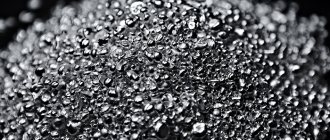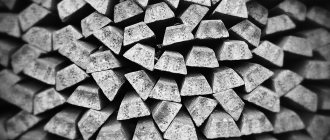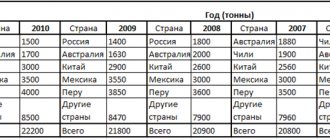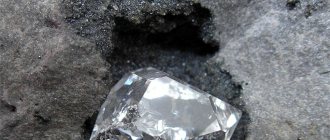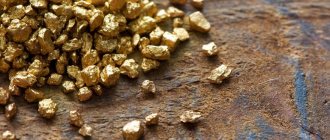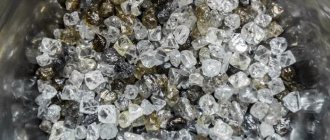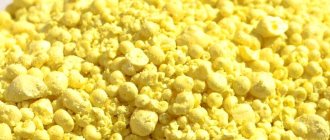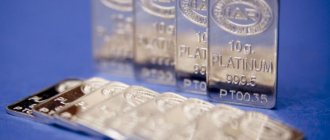The production of precious metals in the world is gaining momentum.
As of 2014, the amount of ore mined increased by 20% to 819 million troy ounces. Researchers at The Silver Institute concluded that at the beginning of the 21st century, the amount of extracted resources increased almost 3 times. Mexico is home to the largest precious metal mining centers in the world. Below Mexico, in terms of the amount of ore mined, are:
- China (3800 tons per year);
- Peru (3,700 tons per year);
- Australia (1900 tons per year);
- Russia (1800 tons per year).
Silver in nature
This is what the ore from which silver is mined looks like.
The main share of nuggets is extracted from polymetallic ores, where it is concentrated in the form of sulfide impurities. As for nuggets, they are rare. Their main share is mined from silver ores.
Nuggets of the precious metal are rare due to the tendency of silver to oxidize and form a black coating on it - aconite. In addition, it reacts with AgCl (chlorogarite) and ClBr (embolite), as a result of which it changes its structure and is sprayed into adjacent metals.
Silver shares
You can invest in individual stocks that give you exposure to the silver industry. There are two main types of companies.
- Silver mining stocks, also called "silver miners": these are stocks that invest in every stage of silver production, from exploration to refining. Therefore, when production expands, the prospects for these companies increase - and, of course, vice versa.
- Silver Stream Stocks: Instead of exploring and producing silver themselves, some companies enter into an agreement to finance a mining project in exchange for a portion of future profits, which are then distributed to shareholders.
You can buy silver stocks, just like any company stock, through a brokerage, investing app, or online trading platform.
Scope of application of precious metal
The world's need for the resource is constantly growing, this is due to the fact that the mineral is used in many areas of industry: about 80% of silver bars are used in the production of equipment, mobile devices, computers, batteries and other modern equipment.
All modern microchips contain precious metals, including silver
If previously silver was used only for aesthetic purposes, today it is mainly used for industrial purposes. It is valued for its high conductivity of heat and electricity. In addition, the mineral cannot be oxidized and has good catalytic properties.
Residues from the industry are used in jewelry and for the production of precious coins. The intensive pace of production has led to the fact that there are almost no resource reserves left. Experts believe that they could be depleted in the next 20 to 30 years at this rate of production. At this point, humanity has depleted about 95% of all silver reserves on the planet.
Physical silver
Physical or investment silver means a precious metal with a purity of 99.9%. It comes in the following forms:
- Bullion: Bullion consists of pure silver that has been poured or pressed into stamped blocks. They can be purchased from reputable dealers. If you choose this form, buy smaller ounce bars as they will be easier to sell if needed.
- Coins and Rounds: Forget about rare or collectible coins whose numismatic value exceeds their silver content. We are talking exclusively about coins issued by government mints for investment purposes only. Some of the most popular bullion coins include the silver American Eagle, Canadian Maple Leaf, and Austrian Philharmonic. Rounds, as their name suggests, have the same shape as coins, but are not official legal tender.
- Junk "junk" silver: dimes, quarters, and half dollars issued by the United States Mint before 1965, after which it stopped using silver in coinage. Anything minted before this time may have contained up to 90% silver, so while it has no collector's value (hence the term "junk"), it has a value based on the purity of the precious metal.
Investment silver can usually be purchased from dealers in various forms. Be sure to look for a well-established one. Many banks also sell bullion coins and bullion.
Silver mining methods
Throughout human history, mining methods have changed. At first, the precious metal was extracted using an open method, but with the improvement of technology, they switched to a closed method. At the present stage, the resource is extracted in two ways - cyanidation and amalgamation.
- Cyanidation is the extraction of metal using an aqueous solution. The alloys are placed in a special solution consisting of cyanide and oxygen. The mineral is extracted from solution after filtering waste rocks. The resulting impurities on the metal are removed with sulfuric acid. The remaining solids are filtered, washed, evaporated and sent to the production of ingots.
Material balance of gold and silver for the technological scheme of ore processing by cyanidation - Amalgamation is an old method that humanity has been using to extract silver for more than 2 thousand years. The silver ore is passed through an amalgamated surface coated with mercury along with water. Particles of the precious metal enter into a chemical reaction with mercury, forming an amalgam - solid formations. The filtration method is applied to the solidified formations, extracting silver ore from it.
Amalgamation of silver is impossible without mercury, so this method is not used so actively.
The described methods cannot produce absolutely pure silver. It is extracted at refineries using the method of cleaning, filtration and secondary processing.
What affects the price of silver?
Now let's look at the key points to consider when investing in silver. Despite what analysts tell us, there are fundamental factors that determine price behavior. Within the framework of protective assets, which includes gold, everything is relatively simple.
Let's highlight the main thing:
- Direction of gold movement. Still, silver is considered a secondary protective asset among metals; the main place here is given to gold. It is this that usually determines long-term downward or upward trends in all groups of precious metals. Therefore, if you want to invest in silver, you should also look at gold. A confident fall over a long period of time may indicate that there will subsequently be a long trade in the price range, it is better to wait and watch, it is never too late to buy. But it’s not very pleasant to sit in the red; there’s no need to rush here. Reversals in precious metals usually occur slowly if we are talking about quiet times.
- State of affairs in the global economy. Everything fits into a simple sequence - the growth of key indicators in the economy causes a decrease in interest in protective assets, including silver. Deterioration in performance leads to an increase in the price of silver. Moreover, all this can be seen both within one week and over a long period. For example, a decrease in the United States' GDP within a quarter will cause an increase in the cost of the metal, but it is unlikely to be long-term. But a trend towards a decline in GDP over several quarters will clearly indicate certain problems, and such events will push prices up. Similarly, with GDP growth, investors will leave metals and the price will decrease.
I also recommend reading:Structured notes (ETN) in investments - what are they? How to buy, risks, taxes
An exchange-traded note is one of the increasingly popular investment instruments actively promoted by modern banks. A note is a type of structural product […]
- Demand for the US dollar . The main financial instrument involving silver is silver for dollars, trading symbol XAG/USD. Accordingly, if interest in the dollar itself in the market decreases, then all other currencies and metals grow in relation to it. Therefore, you can often see a correlation between the main currency pairs (eurodollar, pound dollar) and gold with silver. But this is observed within small trends - a week, a month. If there is a global demand for the dollar, then this is usually due to poor economic prospects and in such situations, metals rise in price, despite the fact that the dollar is rising. That is, we simply focus on the intensity of conversations about the coming crisis and evaluate their adequacy.
All of the above is quite enough to understand the prospects for silver prices. There is no point in going into details, because we are talking about investing in silver, not speculating on it.
The fact that the demand for metal is constant gives us an idea of a certain minimum price below which it is unlikely to fall. At the moment, this range can be called levels of 13-15 dollars per troy ounce (a little more than 31 grams) . At these levels, silver becomes very attractive for long-term investment. There is no need to sit and wait, trying to catch the bottom, it is unlikely. You can gradually buy metal on declines, for example, take 20% of your capital and invest in silver at $15, another 20% at $14.5, and so on.
Mexican mines are the richest deposits in the world
The largest mines in Mexico
Mexico is the world leader in the amount of silver ore and other precious metals mined. On the territory of this state, experts have recorded more than 200 mines where the precious resource is extracted.
Las Torres contains the largest deposits of silver in Mexico. Experts estimate its reserves at 4.3 million tons. The concentration of silver in this region reaches 280 g/t.
The second place in terms of the scale of extracted resources is occupied by the mines of La Encantada, Coahuila state. The total deposit savings amount to about 3.2 million tons of ore.
Relatively large areas of resource extraction are considered to be mines in the states of Hidalgo, Zacatecas and Chihuahua. On the territory of these states there are about 48 small deposits of silver ore, where about 20% of the total volume of mined resource in the state is mined.
It is worth noting that experts noticed a slight decline in exports of the precious metal in Mexico. For the first time in history, the amount of silver mined in the country decreased by 6% as of March 2016. Experts predict a slight decline in production for 2016-2017.
Main silver deposits in Russia
In 1704, the mineral was mined at the state level at the Nerchinsky mines near Lake Baikal in Russia. The government and industrialists made no attempt to discover new deposits until the mid-20th century. During the Second World War and during the Cold War, the development of deposits in the Far East began. Russia ranks first in terms of silver reserves in the world. Almost 10.5% of world savings are concentrated on its territory. The main deposits are located in the Far East, Eastern Siberia and the Southern Urals.
Silver mining in Russia
It is worth noting that Russia does not have such rich deposits of the precious metal as in Canada, Germany or Norway, however, in terms of silver concentration, the Russian Federation surpasses all countries in the world.
Today, silver mining in Russia is carried out in 20 regions in more than 100 deposits. The proportion of silver in the main mines rarely exceeds 100 grams/t. The Dukat deposit (Magadan region) ranks first in the Russian Federation in terms of the number of reserves and the volume of silver production. In second place are the Lunnoe and Juliet deposits of silver deposits in the Magadan region. From these three centers, more than 30% of all silver is mined in Russia. Slightly less is mined in the Urals - about 20%. In third place are the Norilsk and Khakanja deposits, where about 7-10% of the precious metal is excavated.
Silver: silver mining and production
Silver market
The first thing that representatives of the silver industry pay attention to today is a reduction in production volumes by 2% in 2021 (to 26,616 tons). In many respects, the indicators declined due to a decrease in associated production in the production of zinc and lead. Moreover, a decline in production volumes has been observed for the last three years.
Second, 2021 saw a decline in demand for industrial silver, resulting in a 3% decline in overall demand. And thirdly, in parallel, an increase in physical demand of 4% was recorded.
According to forecasts, by the end of 2021, global silver production will increase, in particular due to increased production in Mexico, Argentina and India.
Taking into account the latest trends that are emerging in the market, in general, the silver industry will maintain more or less stable production over the next couple of decades.
However, experts estimate that existing silver reserves will last for about 21 years, provided that production rates remain at current levels. In this regard, the long-term forecast is disappointing: the entire world will enter the threshold of an acute silver shortage.
Silver mining industry in the DPRK
The amount of precious metal mined in China fully meets the state’s needs for the resource. The rest is exported to Japan, Korea, Mongolia, Iran and other countries of the world. About 9.6% of the world's silver reserves are concentrated in China. It is found in lead-zinc and copper deposits.
Transportation of soil saturated with silver ore
Main centers of ore mining: Ying region. In this area, precious metal began to be mined in the late Middle Ages. The Ying region holds the record for silver ore in China. It concentrates about 15 million tons, which is almost 35% of the state’s reserves.
The southeastern regions of China are in second place in terms of the amount of silver ore reserves. The Fuwan field in Guangdong Province stands out in this region. Here ore is mined using a closed method. Experts estimate the deposit's reserves at 9 million tons. It is worth noting that Fuwan is one of the most profitable mines, since the concentration of silver in it reaches 190 g/t.
Thus, the territory of China is a promising place for silver mining. According to data, as of 2015, China ranks second in silver production in the world. Experts predict that China will take first place by 2018-2019 if production rates do not decrease.
Silver production
Silver is a chemical element with the chemical symbol Ag (Greek: άργυρος árguros, Latin: silver, both from the Indo-European root *arg-for "gray" or "bright") and atomic number 47. A soft, white, lustrous metal with the highest electrical conductivity among all elements and the highest thermal conductivity among metals. Silver occurs naturally in nugget form, as an alloy with gold and other metals, and in minerals such as argentite and chlorargyrite. Most silver is produced as a by-product of the refining of copper, gold, lead and zinc. The largest silver mines in the world are Fresnillo in Mexico, Ducat in Russia, and Uchucchacua, Pirquitas and Palmarejo in Peru. The largest mine in the United States is the Greens Creek Mine in Alaska. In 2012, according to the US Geological Survey, Peru had the largest reserves of silver (about 22% of world reserves); The subsoil of Mexico, Australia, Chile, Poland, China and Russia is also rich in ores containing silver. In total, this metal is produced in significant quantities in 50 countries on all continents.
Reserves at silver deposits in 2012, thousand tons *
| Peru | 120.0 |
| Poland | 85.0 |
| Chile | 77.0 |
| Australia | 69.0 |
| China | 43.0 |
| Other countries | 146.0 |
| Total stocks | 540.0 |
* US Geological Survey data
Over the past nine years, global silver production has grown steadily and in 2012 amounted to 787.0 million ounces (24,476 tons). Production from major silver mines has fallen due to lower metal content in the ore, as well as production problems at a number of large enterprises. At the same time, an increase in silver production was noted in enterprises producing the metal as a by-product of lead, zinc and gold. The largest producing country of this metal is Mexico, traditionally followed by Peru, China, Australia, the USA and Chile. Russia is gradually becoming a leader in world silver production; At the end of 2011, in terms of its extraction volumes, the country entered the “seven” of leading producing countries. CPM Group, in its 2013 Silver Yearbook 2013, notes that silver production in 2012 increased by just 16.88 million ounces in Mexico, China, Peru, Australia and Bolivia. Mexico produced a record 136.6 million ounces, and China produced a record 122.2 million ounces. Canadian silver production fell for the eighth year in a row to 17.6 million ounces in 2012. US silver production fell to 36.9 million ounces in 2012. Primary silver miners produced 192.6 million ounces of silver in 2012, or 24.4% of total metal production, according to the report. According to the Silver Institute, the global supply of silver in 2012 increased compared to the 2011 level by 8.9 thousand ounces. up to 1048.3 million ounces (32602 t). At the same time, net sales by the official metal sector decreased by 38% compared to 2010 - to 7.4 million ounces. (230 tons), which was the lowest figure in the last 14 years. Over the past few years, the cost of mining primary silver for industrial enterprises has gradually increased, reaching an average of $10.04/oz in 2012. down from $8.44/oz. a year earlier, due to an increase in the wage fund and a decrease in the content of useful components in ores. At the same time, thanks to the increased average annual sales price, the profitability of silver mining enterprises was at a fairly high level.
Silver production in the world, tons*
* US Geological Survey data
For centuries, silver has been valued as a precious metal and has been used as an investment, as well as for the production of jewelry, fine tableware, and coins. Today, silver is also used in electrical contacts and conductors, in mirrors and in catalysis of chemical reactions. Its compositions are used in photography, and solutions of silver nitrate and other silver salts are used as disinfectants and microbiocides. Although the use of silver in medicine has declined in recent decades due to the use of antibiotics, further research into the antibacterial properties of this metal continues. Total demand for silver, according to The Silver Institute, in the industrial sector was 846.8 million ounces in 2012, down 6.6% from last year. In 2012, silver use in core industries fell 4.5% to 465.9 million ounces. According to analysts, the Eurozone crisis had a negative impact on demand, which led to a decrease in the indicator for the year as a whole. This happened even as China's silver consumption increased due to household purchases, strong demand from the auto industry and rising infrastructure spending. Global silver jewelry demand decreased to 185.6 million ounces due to volatile prices and a weak global economy. Silver use in photography fell to 57.8 million ounces, the smallest decline in six years. The decline was due to the increasing use of digital systems. Finally, demand for silver commodities fell to 44.9 million ounces due to global economic weakness and ongoing structural losses.
Production and consumption of silver in the world, million ounces*
| year | 2008 | 2009 | 2010 | 2011 | 2012 |
| Total production | 683.0 | 713.6 | 752.7 | 757.0 | 787.0 |
| State sales | 30.5 | 15.6 | 44.2 | 12.0 | 7.4 |
| Secondary production | 200.8 | 199.8 | 228.8 | 258.1 | 253.9 |
| Hedging | — | — | 50.4 | 12.2 | — |
| Disinvestment | — | — | — | — | — |
| Total production | 914.3 | 929.1 | 1076.2 | 1039.4 | 1048.3 |
| Industry | 490.9 | 403.6 | 500.7 | 487.8 | 465.9 |
| Photo | 101.3 | 79.3 | 72.1 | 66.1 | 57.8 |
| Jewelers | 179.1 | 178.7 | 192.8 | 186.5 | 185.6 |
| Silver goods | 59.8 | 55.0 | 52.8 | 48.3 | 44.9 |
| Coins | 65.3 | 78.8 | 99.4 | 118.3 | 92.7 |
| Total industrial demand | 896.4 | 795.4 | 917.9 | 907.1 | 846.8 |
| State procurement | — | — | — | — | — |
| Dehedging | 8.7 | 17.4 | — | — | 41.5 |
| Investments | 9.3 | 116.3 | 158.3 | 132.3 | 160.0 |
| Total consumption | 914.3 | 929.1 | 1076.2 | 1039.4 | 1048.3 |
*data from The Silver Institute (World Silver Survey)
Silver trading now takes place around the clock around the world, including the world's major commodity markets in London, Zurich, New York, Chicago and Hong Kong. Silver trading began in London back in the 17th century and, to this day, the city remains the center of physical trade in this metal for most countries. However, the COMEX division of the New York Mercantile Exchange is the leader in paper contracts in the silver market. The spot price of silver – the current price of silver that reflects market variables and expectations – is determined by the COMEX. Overall, the price of silver is determined primarily by supply versus industrial demand. In recent years, demand for silver on the global market has significantly outpaced production volumes, resulting in the need to use existing reserves to meet needs. While available sources of silver continue to dwindle, the underlying value of the metal is strengthening. However, since silver is a tangible asset and is recognized as a store of value, its price can be affected by factors such as inflation (real or perceived), changes in the value of paper money, and fluctuations in shortages and interest rates. In mid-February 2013, silver was priced at approximately $31.0/oz, i.e. 1/53 of the price of gold. This ratio has varied over the last century from 1/15 to 1/100. In 1980, the price of silver rose to its maximum of $49.45/oz. due to market manipulation by Nelson Bunker Hunt and Herbert Hunt. At 2012 prices, this is approximately $138/oz. Some time later the price returned to $10/oz. From 2001 to 2010, the price of silver increased from $4.37/oz. up to $20.19/oz. (London fixing average). According to The Silver Institute, the recent rise in the price of silver has come as a result of increased investor interest in the metal and increased industrial demand. At the end of April 2011, silver reached an all-time high of $49.76/oz. However, in earlier times, silver prices were much higher. In the early 15th century, the price of silver is estimated to have surpassed $1,200/oz in 2011 dollars. The discovery of massive silver deposits in the New World over the following centuries caused the price of this precious metal to decline significantly. The average annual silver price in 2011 was $35.11/oz, more than double the 2009 average ($14.67/oz). In 2012, the price of silver decreased slightly to $31.16/oz, but continued to remain at a very high level.
Silver prices, dollars/oz.
Secondary silver supply is at risk in the coming years, driven by reduced levels of hedging and public sector sales. Net sales of silver from various government reserves already at the end of 2012 decreased to a 14-year minimum level of 7.4 million ounces, including due to a decrease in supplies from Russia. Scrap supply increased primarily due to increased recycling of jewelry and silverware amid strong metal prices. At the same time, the world's leading silver producers are increasing their production, which is causing an excess supply of the metal on the world market. Mexican, which is a branch of the Mexican structure Industrias Penoles, the world's largest silver producer, intends to double silver production in the next ten years. In general, the mining of silver ores attracts the most investment in Mexico and Peru; Canadian companies, Great Panther Resources, Endeavor Silver, Fortuna Silver Mines, as well as Pan American Silver, which also operates , in Argentina. Investments in the mining industry are quite large; many producers do not plan to reduce silver production volumes. Indian is the largest Indian producer of this metal (about 3.2 million ounces per year). It is expanding its production capacity to 16 million ounces. per year, the immediate goal at the end of 2013 is to achieve an increase in output by 20%. American, which operates assets in the United States (Nevada and Alaska), is increasing its silver production thanks to the start of production at the San Bartolome deposit in Bolivia, where the cost of production is $6.74/oz. is one of the world's largest silver producers, also conducting mining and exploration work in Chile, Argentina, Australia and Mexico. Expected growth in silver supply from new deposits, including associated mining, could mitigate metal market fundamentals, supporting long-term supply growth, while robust industrial demand should reassure investors that silver will become a better investment than gold in long term. Consulting firm CPM Group predicts that Mexico, one of the world's largest silver-producing countries, will produce 137.7 million ounces of silver in 2013. The company expects production in China to grow by 5% to 128.3 million ounces in 2013. US silver production is forecast to rise to 41.2 million ounces. The fall in the price of silver in 2013, according to CPM Group forecasts, will not affect primary production, which is forecast to reach a record 721.1 million ounces in 2013, up from 698.3 million in 2012.
Silver mining in Peru
The mining industry in Peru is considered one of the most developed in the country. Experts note that Peru produces about 17% of the world's silver ore reserves. According to data, as of 2015, there are about 784 mines operating in the state. Mines with a total reserve of more than 120 thousand tons remain unopened and unprocessed.
Silver production ramps up in China and Peru
Industrial extraction of the precious resource in the country began in 1991, when the government lifted restrictions on the extraction of the country's national wealth. It is worth noting that almost 75% of all mines belong to foreign investors and their capital.
The largest deposits in Peru are concentrated in San Rafael (Eastern Cordillera). Almost 27% of the country's total reserves are located here. It is worth noting that San Rafael contains the richest reserves with a high concentration of silver up to 230 g/t.
Second place is occupied by 4 mines located in Hulkani, San Cristobal, Gulkenia and Morococha. They account for about 14% of the country's total reserves. The extraction of silver ore in these areas is carried out using a closed method.
The country is considered one of the wealthiest in the world. Remains from industry are exported to neighboring countries. Peru has the closest trade relations with European countries. They supply about 80% of all silver for export.
What is the best way to invest in silver?
Each method of investing in silver has its own benefits and risks.
Investing in physical silver has traditionally been considered the purest form of investment: you own the actual precious metal, and it can be bought and sold for an amount equivalent to the market or spot price of silver per ounce (plus a small premium - higher for coins than bars). But this method requires large costs for storage and insurance.
Additionally, coins and bars do not earn interest or dividends. You won't be able to measure the profit until you sell them - at best, at a higher price. But even then, you'll be faced with shipping costs and other fees that can eat up your entire profit.
On the other hand, silver stocks, funds, and ETNs provide some diversification to your portfolio without forcing you to fork out for storage space. They are more liquid and trade daily. And, of course, they are convenient to buy and store in a regular investment account. Paper silver is an easy and often lower-cost way to gain exposure to the precious metals market, especially if you choose a silver ETF or mutual fund.
But these are indirect investments. As with any company, a silver company's operating expenses, reserves and management play an important role in its performance; as well as political and economic conditions. As a result, silver stocks can be volatile, adding to the already wild price swings that silver is subject to.
Australian mining industry
The island nation ranks fourth in the world in terms of the amount of silver mined. Last year, local entrepreneurs produced almost 55.4 million ounces of this resource. It is worth noting that in Australia the mining industry is developing at a fairly rapid pace. The first mine was built by local residents in 1840 in Tasmania (Reed-Rosbury). The valuable resource was mined using a closed method from lead, zinc and gold.
The main deposits are concentrated in the southwest of the mainland - in the state of Western Australia. The largest mines are located near the cities of Kalgoorlie
BHP Billiton is a leading silver and lead mining company in Kirrington, western Queensland. In 2015, the company received approximately 32.12 million ounces of the resource. Currently, BHP Billiton mines and produces about 43% of the resources in the entire territory of Australia.
The second large mine is considered to be Mt. Isa in Queensland. Here, mining companies extract deposits of silver ore using a closed method. The Mac Arthur River mine is the third most important. It produces about 15% of all Australian iron.
It is also worth noting the giant companies Xstrata ADR and Minmetals Recources. They own small deposits in the western lands (South Wales and Broken Hill).
